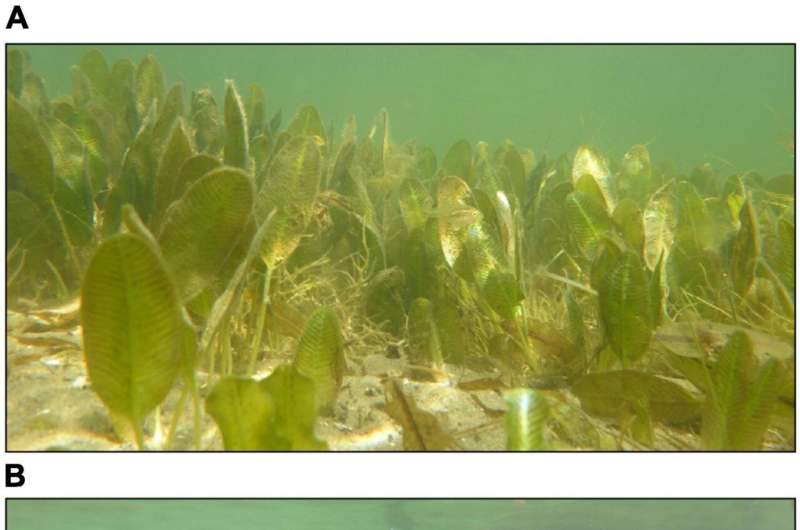Seagrass (Halophila ovalis) in the Swan-Canning Estuary (A) and black swan (Cygnus atratus) grazing (B). Credit: Frontiers in Plant Science (2022). DOI: 10.3389/fpls.2022.947109
In an Australian first, scientists from Edith Cowan University (ECU) have determined how long it takes for seagrass to recover after grazing by swans.
The project, led by ECU Master's student Caitlyn O'Dea, used floating pens in Perth's Swan River, to keep swans away from the seagrass to allow tracking of its recovery.
Seagrasses are the only flowering plants that can live underwater and are considered amongst the most productive ecosystems in the world. However, climate change, coastal developments and run-off from urban, industrial, and agricultural areas have all led to its ongoing global decline.
Grazing has also led to complete loss of seagrass in some marine ecosystems. "To simulate grazing, we removed a quarter, half, three-quarters and all the seagrass in parts of the meadow," Ms. O'Dea said.
The experiment was set up at Mosman Park, Nedlands, Crawley, Attadale and Como.
The regrowth of seagrass was tracked weekly to fortnightly over a three-month period, leading to the first official recordings of its recovery time.
"The findings revealed that when grazing was less intense, the recovery time was four to six weeks. Under greater grazing intensity, the seagrass took seven to 19 weeks to recover," Ms. O'Dea explained.
With a decrease in area of seasonal wetlands across in Western Australia due to the drying climate, black swans are likely to be more common in the Swan River.
"Seagrass not only provides a vital food source for birds and other animals, but it also provides habitat and shelter as well as improves water quality, so increased grazing pressure on seagrass could have implications for the ecosystem as a whole," she explained.
Ms. O'Dea said the research also identified seagrass recovery was most commonly through vegetative measures, as opposed to sexual reproduction.
"Seagrass has rhizomes which can grow into areas like the horizontal runners of grass in your backyard. They can also flower and produce seeds, which for this species lay dormant in the sediment. We didn't observe any recovery through reproduction, which could simply be due to the time of year, as we'd expect to see germination in spring."
Ms. O'Dea said her research will allow for further examination of how grazing and other potentially interacting pressures could impact seagrass ecosystems even further.
The study is published in Frontiers in Plant Science.
More information: Caitlyn M. O'Dea et al, Increased extent of waterfowl grazing lengthens the recovery time of a colonizing seagrass (Halophila ovalis) with implications for seagrass resilience, Frontiers in Plant Science (2022). DOI: 10.3389/fpls.2022.947109
Journal information: Frontiers in Plant Science
Provided by Edith Cowan University
























